 |
|

|
 |
TABLE of CONTENTS
 |
2014 construction program kicks off with more than 300 projects |
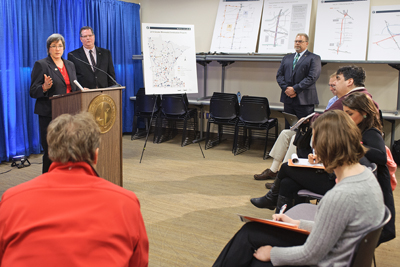
Sue Mulvihill, deputy commissioner/chief engineer, and Tom O’Keefe, Metro District program delivery director, answered reporters questions during the construction kickoff news conference April 3 in St. Paul. Photo by David Gonzalez |
More than 300 construction projects scheduled for 2014 were announced at the construction kickoff news conference April 3. The $1.1 billion program includes work on 74 projects in the Twin Cities and 194 projects in Greater Minnesota. An additional 40 projects statewide will improve safety at railroad crossings, and make improvements on runways and terminals at regional airports. The work includes projects funded by the Corridors of Commerce program, a bonding effort aimed at improving roadways for freight travel.
"This program will provide vital upgrades to our transportation system," said Commissioner Charlie Zelle. "The Corridors of Commerce projects will ensure that roadways important to business use will get needed improvements."
Zelle and Deputy Commissioner/Chief Engineer Sue Mulvihill discussed MnDOT’s overall program and transportation goals for 2014, while Tom O’Keefe, Metro District program delivery director, addressed what motorists can expect on the Twin Cities area roadways this year. Lt. Eric Roeske, Minnesota State Patrol, provided safety messages for the driving public.
District staff and their local news media participated in the news conference via live-streaming on the Internet.
High-impact projects in the Twin Cities area include:
- Interstate 35E between I-94 in St. Paul and Little Canada Road, MnPASS Express Lanes construction, pavement and bridges replacement and traffic management technology improvements
- Hwy 65 from Fridley to Spring Lake Park, pavement replacement and safety improvements to the highway and bus stops
- Hwy 100 bridge replacements and highway widening from 36th Street to St. Louis Park
Projects in Greater Minnesota include:
- Hwy 29 complete streets reconstruction in downtown Alexandria
- Hwy 34 passing lanes construction from Detroit Lakes to Nevis (a Corridors of Commerce project)
- I-94 additional lane construction from Hwy 101 to Hwy 241 (a Corridors of Commerce project)
- I-35 in Owatonna reconstruction and bridge replacement
"We will ensure that these roadway investments get the most for taxpayer dollars," Zelle added. "The public deserves smooth, safe roads that are built and maintained efficiently."
Because of the number of work zones motorists will encounter as crews perform road construction and maintenance work, MnDOT asks drivers to be alert on the road this summer.
To view a video recording of the construction kickoff news conference, visit https://www.youtube.com/watch?v=d3rlahvH9IM&feature=share.
For a complete list of projects, including construction dates and traffic impacts, visit www.mndot.gov/construction.
In addition, keep informed about projects and other transportation topics by connecting to MnDOT via social media, as well as signing up to receive email updates at www.mndot.gov.
|
 |
|

|
 |
TABLE of CONTENTS
 |
Enhancing Financial Effectiveness project teams report their progress |
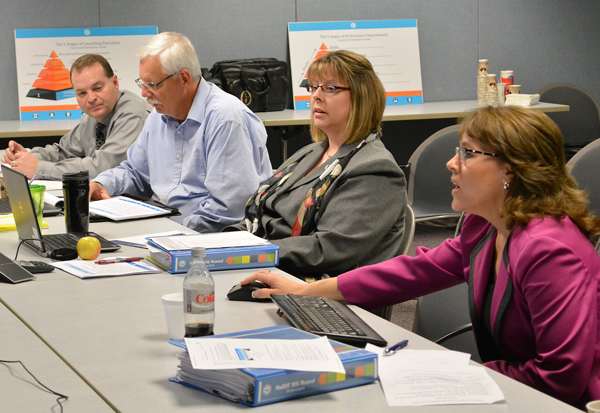
From left, Trent Weber, Human Resources; Bill Roen, Enhancing Financial Effectiveness Project director; Tracy Hatch, deputy commissioner, chief operating officer and chief financial officer; and Mary Prescott, Strategic Initiatives manager; discuss the EFE program during a meeting April 10. The EFE project teams reported their progress during the meeting. A summary of the reports will be posted to the EFE iHub website the week of April 21. Photo by Rich Kemp |
|
 |
|

|
 |
TABLE of CONTENTS
 |
MnDOT to honor fallen workers April 28 |
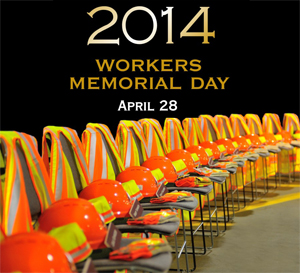
Illustration by Jane McNamara
|
MnDOT employees from around the state will honor fallen transportation workers during Workers Memorial Day on Monday, April 28.
Several events will take place statewide to honor workers who were killed or injured on the job, including:
- 9 a.m. – District 6/Rochester maintenance facility
- Noon – District 7/Mankato - 500 S. Front Street
- 1 p.m. – Metro District, Chaska Truck Station
The agency’s statewide observance will be highlighted by a message from Deputy Commissioner Sue Mulvihill, followed by a moment of silence at 2 p.m.
Since 1960, 34 MnDOT workers and 15 contractors lost their lives while working on Minnesota highways.
April 28 is recognized nationally and locally since 1989 as a day of remembrance of workers who were injured or killed on the job. |
 |
|

|
 |
TABLE of CONTENTS
 |
Green with Envy challenge kicks off on Earth Day |
By Sue Roe
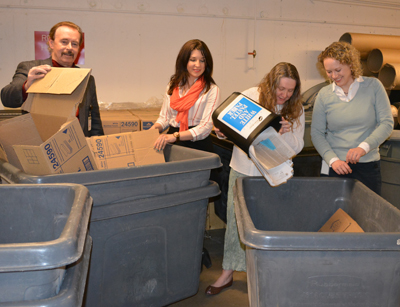
Scott Bradley, Jenny Morris, Cindy Carlsson and Sara Dunlap, members of the sustainability working group, dump cardboard and paper products in the recycling area in the basement of Central Office. This is where all recyclable materials are brought once they are collected from offices throughout the building. Photo by Sue Roe |
Employees are invited to participate in Earth Week activities April 21-25. The sustainability working group is sponsoring events to raise awareness and inspire employees to reduce their impact on the environment.
“Earth Day and Earth Week is a great opportunity for MnDOT employees to individually and collectively do something to further MnDOT’s environmental stewardship and sustainability goals,” said Scott Bradley, Office of Environmental Stewardship. “If we all take some small actions, we cumulatively contribute to a large and positive impact in moving forward.”
The working group is sponsoring a Green with Envy challenge to give all employees an opportunity to make positive differences and motivate others in their workplaces. Bradley said employees can submit a report by the end of the year. Groups will be recognized for their projects.
“Employees should not be surprised if they have fun participating in the challenge,” he said.
The challenge will officially kick off on Earth Day, April 22. Participants in the challenge can make their project or activity as creative or easy as they like.
“Many of the environmentally friendly things we can do as individuals, groups and as an organization are very simple and easy,” Bradley said. “We would be likely to do them anyway if we realized how we could save money and resources.”
Projects such as taking an alternative method of transportation to work, composting as a waste stream reduction and source of natural fertilizer, planting low-maintenance and drought-resistant trees and vegetation, and using “green driving” practices all positively affect the environment and save money.
At Central Office, the working group is posting display boards on each floor through the end of April with tips about conserving energy, water and other resources. A cafeteria display offers tips on recycling, including what MnDOT currently does to reduce, reuse and recycle.
On Tuesday, April 22, MnDOT’s electric vehicles will be on display on John Ireland Boulevard from 10 a.m. to 2 p.m. Every half hour there will be demonstrations on how the Chevy Volt and Toyota Prius operate. Employees can also take test drives.
District 1 will observe Earth Week byhaving a week-long clean up to remove excess furniture, paper and other unneeded materials in and outside of all facilities. Employees will also properly archive documents and files, and clean, recycle and reuse items.
Earth Day was first observed in 1969. Environmental laws such as the Endangered Species Act, the National Environmental Policy Act, the Clean Air Act and Clean Water Act all were passed in the 1970s, which is considered the birth of the modern environmental movement.
Members of the sustainability working group’s Earth Day committee are: Scott Bradley, Office of Environmental Stewardship; Cindy Carlsson, Office of Government Relations; Sara Dunlap, Statewide Multimodal Planning; Jenny Morris, Office of Project Management and Technical Support; and Marilyn Jordahl Larson, Office of Environmental Stewardship. For more information, visit the sustainability team’s updated webpage. |
 |
|

|
 |
TABLE of CONTENTS
 |
Crookston’s Charlie Hoff dies unexpectedly |
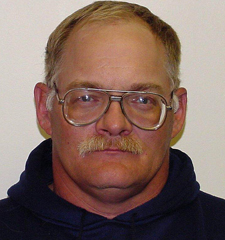
Charlie Hoff, a transportation generalist in District 2, worked for MnDOT for 24 years. Photo courtesy of District 2 |
Charlie Hoff, a transportation generalist in District 2, died suddenly at the Crookston truck station April 1. Hoff, 59, joined MnDOT in 1988 at the Thief River Falls truck station. Later that year he moved to Crookston and continued to work in maintenance during his time with MnDOT.
Colleagues say Hoff was very hard working and was always willing to help.
“He was very dedicated. I could call him at any time of the day,” said Domingo Aguilar, Hoff’s supervisor in Crookston. “He was always there, always answered his phone.”
Hoff also played a key role in the Crookston-area flood fight. He prepared the equipment, such as pumps and hoses, in advance of each spring flood season.
This winter, Hoff begrudgingly agreed to use a brand new plow truck. He suggested one of his colleagues should use it.
“He never wanted anything new, didn’t want much change,” said Aguilar. However, once Hoff started using the new truck, “he loved it.”
Outside of MnDOT, Hoff served in the Minnesota National Guard for 21 years.
Hoff is survived by his wife, Wendy; three children, Adam, Megan and Toni; and one granddaughter, Elliona.
Funeral services were held April 7 in Crookston. Military honors were provided by the Crookston Veterans Council and the Minnesota National Guard Honors unit from Moorhead. |
 |
|

|
 |
TABLE of CONTENTS
 |
Co-workers mourn death of District 6’s Adam Jensen |

Adam Jensen, Owatonna Radio Shop in District 6, died April 1. Photo courtesy of District 6 |
Adam Jensen, a radio technician at the Owatonna Radio Shop in District 6, died April 1 from injuries sustained in an automobile accident.
Jensen, 30, attended Riverland Technical College for electronics and worked for Whitewater Wireless in Faribault before joining MnDOT in March 2013.
“He was probably the most dedicated and intelligent person I have ever hired,” said Marshall Robeck, Jensen’s supervisor in Owatonna. “He never wasted any time and just when you thought he had enough work to keep him going all day, he would be back in the shop three hours early, looking for something to do.”
Jensen liked to fish with his sons and go on family camping trips. He loved farming with his dad and brother.
“He was big at 6 feet 6 inches tall and very soft spoken,” said Robeck. “However, when he had something to say, he was worth listening to.”
Jensen is survived by his wife, Kelsey; sons, Milo and Owen; his parents, Michael and Phyllis; his brother, Derek; and sister, Marissa.
Funeral services were held April 5 in Owatonna.
|
 |
|

|
 |
TABLE of CONTENTS
 |
Susan Brenner, Labor Relations consultant, dies at 65 |
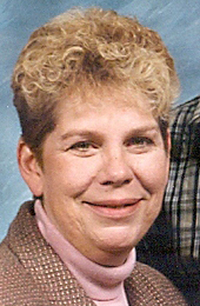
Susan Brenner, a labor relations consultant, worked for MnDOT for 27 years. Photo courtesy of Brenner family |
After battling cancer, Susan Brenner, 65, Labor Relations consultant in the Central Office, died April 6.
Brenner started with MnDOT in 1986 at the Golden Valley Office. Most of her 27 years were spent in the Metro District in the Human Relations and Labor Relations Office. She moved to the Central Office in November 2013.
“I worked with Sue for the last eight years and she was always someone I would bounce ideas off and get her input,” said Mary Stohr, Metro Human Resources director. “I do not know of one person in our office that didn't love going to Sue for advice, whether personally or professionally.”
Brenner was a 1966 graduate of Delano High School. She loved to go to Cancun and spend time at the cabin. She enjoyed reading and surfing the Internet.
“Her family was so important to her and her face would light up when she talked about her family,” said Stohr.
Brenner is survived by her husband Dick; children Kelly, Nicole, and Joe; grandchildren Jessica, Katie, Colleen, Jade, Johnny and Sally; and brother Larry.
A memorial service was held April 10 in Delano.
|
 |
|

|
 |
TABLE of CONTENTS
 |
Edward Fairbanks named new tribal liaison |
By Rich Kemp
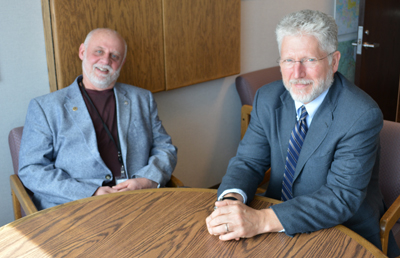
Edward Fairbanks, tribal liaison, and Scott Peterson, Government Affairs director, discuss MnDOT’s relationship with Minnesota’s Indian tribes. Photo by Rich Kemp |
The Office of Government Affairs has selected Edward Fairbanks as the new tribal liaison. Fairbanks will train with Linda Aitken, who has served in that role since 2001, until her retirement later this year.
Born and raised on the Leech Lake Reservation, Fairbanks is a member of the Bear Clan of the Minnesota Chippewa. Fairbank’s father was on the Leech Lake Tribal Council for 16 years and his mother served on the local Indian Council for 12 years.
“Edward comes into the Tribal Liaison position with a great deal of experience and is widely known and respected for his previous work by Indian people throughout Minnesota,” said Scott Peterson, Government Affairs director.
Fairbanks has worked for the U.S. Forest Service, the Minnesota Pollution Control Agency, was division director of the Leech Lake Resource Management Division, and was natural resource specialist with the Bureau of Indian Affairs. Most recently, he was with the U.S. Environmental Protection Agency as tribal liaison for the 11 tribes in Minnesota.
“I hope to complement the wonderful foundation that Linda Aitken has built,” said Fairbanks. “I think I can bring the environmental and natural resource aspects to the table.”
Fairbanks attended Cass Lake High School and Brainerd Technical College, but said his education really comes from a very strong father and mother.
“I learned a lot from my father,” said Fairbanks. “As kids, we would listen to my father and the tribal chief talk for hours and hours about duty and responsibility.”
With a solid foundation in place, Fairbanks is ready for what lies ahead.
“There will be a lot of challenges on the part of MnDOT and the tribes,” Fairbanks said. “How do you keep the transportation process going and how do you maintain it, especially in the rural areas of the reservations? How do you bring it up to some sort of standard to protect the health and welfare of the people? So I envision this as a long-term investment and partnership with the state of Minnesota.”
Fairbanks, his wife Joyce, and daughter, Anna, live on the Leech Lake Reservation.
He will work in the Transportation Building in St. Paul and from a remote office in Cass Lake. He can be reached at edward.fairbanks@state.mn.us. |
 |
|

|
 |
TABLE of CONTENTS
 |
Online learning course available for purchasing card users |
By Sue Roe
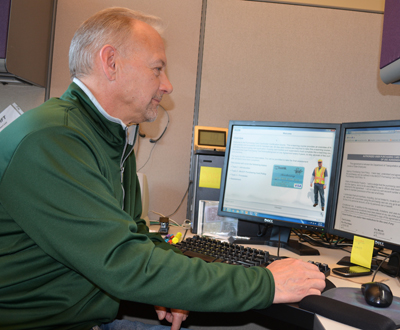
Craig Gardner, director of the Materials Management Office, reviews the online learning component for people applying or reapplying for purchasing cards. The online course is now mandatory in the application process. Photo by Sue Roe |
Employees using or applying for purchasing cards, or pcards, will notice changes in the application and recertification process. Most notable will be a required one-hour online learning course that must be completed before the application is processed.
Pcards are used by employees to pay for small dollar, business-related expenditures such as hotel rooms, parking fees, conference registration and non-contract items.
The cards save MnDOT processing costs and time through a streamlined purchasing process. They also offer employees a convenient way to pay for goods and services. About 450 MnDOT employees have pcards.
“The online course will help employees better understand the policy requirements,” said Cindy Peick of the Materials Management Section. “The course goes through the policy, processes, roles and responsibilities. There will be an assessment at the end that provides the certificate of completion, which needs to be attached to the application.”
Peick said current cardholders and their supervisors are now being notified about the online course requirements. Current pcard holders and cardholder’s supervisors must complete the course every three years to be recertified.
The purchasing card policy was also updated and contains clarifications about how the card can and cannot be used. Peick said she recommends employees who have pcards or want to apply for one to go online and review the purchasing card policy.
Changes have also been made to the application forms. There are now two versions of applications, one for new accounts and recertifications, and one for account changes.
Peick said pcards are one method employees use to make purchases and each department’s purchasing staff can help employees decide if a pcard is the appropriate method for their needs.
The Purchasing Card Cardholder Training course number is ADMN00114. |
 |
|

|
 |
TABLE of CONTENTS
 |
MnDOT, LRRB solicit new research ideas |
By Shannon Fiecke, Research Services & Library MnDOT Research Services is collecting ideas for new research projects for the next fiscal year.
Visit the MnDOT Transportation Research Collaboration website to submit your idea and vote on others’ ideas. The submission deadline is May 30. The MnDOT Transportation Research Innovation Group and the Local Road Research Board will select the best ideas to solicit contract proposals from university researchers.
Research ideas are solicited once per year. Each research project starts from a new idea or the continuation of a previous idea based upon new findings.
“Projects are aimed not only at improving the safety and mobility of fellow Minnesotans, but also the financial effectiveness of our business,” said Hafiz Munir, research management engineer .
Visit the Research Services website for further details. |
 |
|

|
 |
TABLE of CONTENTS
 |
On the job: Bev Herfindahl coordinates statewide future transit efforts |
By Mary McFarland Brooks
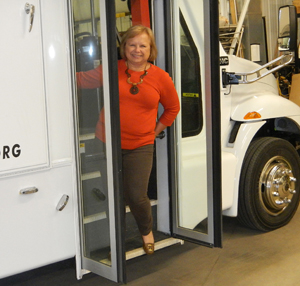
Bev Herfindahl works with transit operations in District 4 and District 8. Photo by Judy Jacobs |
Bill Clinton was president and Jesse Ventura resided at the Minnesota governor’s mansion when Bev Herfindahl joined MnDOT’s District 8 office in 1999. She had recently left a management role at Prairie Five RIDES transit organization, where she oversaw the volunteer drivers network and grant application efforts.
Herfindahl said when she came on board her role was to oversee the transit goals of the agency.
“MnDOT had begun providing service in Greater Minnesota in the late 1980s and has continued to work with local county and city governments to expand service throughout the state,” she said.
After several years of working with the transit program in District 8, Herfindahl became coordinator of the Transit for Our Future initiative in 2011. This initiative began as an effort to refine MnDOT’s process for evaluating applications for public transit funding under preservation or contraction scenarios, as state forecasts predicted lower funding levels for transit. Realizing the initiative provided a path to improve transit under any funding scenario, the effort continued with advice from an expanded Public Transit Advisory Committee, consisting of various transit providers throughout the state.
What were the biggest challenges with the program?
One of the biggest challenges that emerged for transit organizations is the increased federal expectation for documentation that regulations are followed. The initiative proved to be successful by encouraging public transit systems to partner throughout the state to provide a more efficient method of providing transportation.
What kind of changes have you seen in the program?
Prairie Five RIDES merged several of the city systems into its organization since I left my management role there; so a five-county system with dedicated service in one city has grown into a five-county system with dedicated service in six cities.
The other change is innovative software used to route and dispatch vehicles, which helped significantly with directing buses throughout the region. Some things have not changed. Service delivery still remains a demand response type service, which means, a customer calls to a dispatch site and a bus with a driver responds to provide the ride.
How do the funds work for the transit system?
Since a portion of funding for public transit comes from the state’s general fund and motor vehicle sales tax, obviously expansion is dependent on availability of dollars. The other sources of funding for public transit are the federal government with a local share from the grantees, which includes cities and counties. The local share for a transit operating service is usually a 15 or 20 percent match.
The state's local human services plans determine the transportation needs for a county or region and Herfindahl also reaches out to them to establish how best to meet these needs and to look for local cost sharing.
What areas do you cover?
I work with transit operations in District 8, but also have responsibility for District 4’s transit outreach, in addition to responsibilities as coordinator of the Transit for the Future statewide effort. In that role, I interface with MnDOT’s district transit project managers as they work with transit organizations in their respective counties.
Although each district is not represented, the current list of Greater Minnesota transit project managers includes:
• Don Mohawk, District 1, tribal coordinator
• Kent Ehrenstrom, District 2, facility coordinator
• Sue Siemers, District 3, mobility manager
• Jean Meyer, District 6, procurement coordinator
• Jan Klassen in District 7, asset management coordinator
What is the role of the District TPMs?
It includes working with transit organizations regarding customer access and service with an emphasis on efficient system management. I oversee these efforts and am also involved with collaborating with cities, counties and transportation providers regarding MnDOT’s share in facility and operating costs.
My efforts to streamline and look for efficiencies in the statewide transit system along with the district TPM’s local objectives along these same lines are examples of the agency's overall efforts to demonstrate effective and efficient stewardship of public resources.
With so much time on the road, do you ever make it home?
I make it home occasionally to the family farm in Boyd, outside of Marshall, which I share with my husband.
What do you do in your spare time?
I enjoy making craft beers, while my husband is engaged in making wine.
Do you or a co-worker have an interesting job to share with readers? Click here to send us your ideas, and we’ll contact you for more information.
Recent employee profiles:
|
 |
|

|
|
| |
|



